Key Takeaways
- Wikis help engage students in their learning while providing social interaction with their peers in the learning process.
- A wiki assignment should enable students to work at the conceptual level of understanding on authentic projects where they can solve problems, discover relationships, discern patterns, and develop a deep understanding of content.
- At the heart of a wiki project is collaborative knowledge building by students mediated by user-generated design, as explained in this article.
Millennial students want learning environments that engage them in their learning, reflect their fearlessness with technology, and provide for social interaction with their peers in the learning process.1 Newer models of learning specify a participatory culture of learning where the instructor shifts from knowledge provider to guide, helping students gain understanding and make meaning through authentic activities that enable them to learn from and with classmates.2 Although learning management systems (LMSs) provide discussions, blogs, and journals, many instructors have found that wikis meet the needs of the changing educational environment by allowing students to take ownership of their learning as they collaborate on projects.3
Getting Started
Numerous companies offer wikis, many of them free of ads, at low or no cost to the individual educator. WikiMatrix provides a comparison of wiki features for 21 wiki packages for those just getting started. Issues to consider include:
- Privacy, which is particularly important in academic settings. Many wikis offer "class member only" settings.
- Scalability, especially whether a wiki limits the number of pages or storage space. Most free wikis provide unlimited pages and 2 gigabytes of storage, but they limit folders and page access controls to paid subscriptions.
- Power of the underlying engine, specifically whether it can handle the volume of visitors. Campus technical support might want to determine this capability.
- Portability, or the ability to export the wiki site. Free wiki software may not offer tools to easily export the site, whereas paid subscriptions do.
- Also, the types of files supported, whether WYSIWYG editing is available, and whether tech support is available.
It might help to visit wiki sites similar to the one being contemplated from each of the providers under consideration. Three of the most popular wiki vendors for educators include PbWorks.com, Wetpaint.com, and Wikispaces.com.4
At the institutional level, there are several options for setting up wikis for faculty including free and open-source software, institutional subscriptions to hosted software, and wikis embedded in the institution's LMS. Some institutions might prefer to self-host wikis by setting up "wiki farms" on university servers with open-source wiki software such as MediaWiki or Twiki. Self-hosting affords administrative and data control, but it comes with administrative costs for installing patches and updates, as well as spamming issues.5 Hosted services such as PBWorks, Wikispaces, and Wetpaint offer institutional subscriptions to ad-free, fully functional wikis, although the most promising solution for institutions may be the incorporation of wikis into the LMS. Some LMS providers such as Angel and Moodle already provide wikis embedded in the courseware, while others such as Blackboard promise that upcoming releases will include embedded wikis.
With a wiki platform selected, the next step is setting it up. Setting up a wiki means registering with the wiki provider and giving the site a name. To make the URL memorable for students, we usually name the wiki using the course number, such as EDED5320.pbworks.com. Once registration is complete, the wiki provider will assign a URL that includes the course name. When students visit the website for the first time, they can request an invitation, which triggers an e-mail to the instructor to grant access.
Designing Wikis for Learning
Designing the wiki learning space before a course begins guides student input and enables students to successfully complete the wiki assignment. Wiki design includes creating pages, assigning permissions as to who may write on a page, or creating a table or grid for student contributions on the pages. It also helps to provide clearly written directions on a page on the wiki.
The wiki assignment should enable students to work at the conceptual level of understanding on authentic projects where they can solve problems, discover relationships, discern patterns, and develop a deep understanding of content. The following sections describe wiki learning designs that we have used in our courses for both long-term and short-term assignments. Unlike blogs or discussion boards, which are designed to facilitate conversation, share opinions, resolve conflicts, or achieve agreements,6 these wiki designs provide a malleable environment for students to co-create knowledge by juxtaposing their contributions as part of the whole.
Long-Term Designs
Many courses use wikis as a group project space where classes create a research paper or a group project with pages for specific topics. In our courses, we have used the group project approach in a graduate foundations course where student groups created pages about different learning theories. The wiki was set up with a main page, which served as a table of contents, and one page for each learning theory. Rather than simply producing a paper or a PowerPoint presentation, students found it really intriguing to create pages where they could hyperlink text and integrate media to create a multimedia representation of their content (see Figure 1).
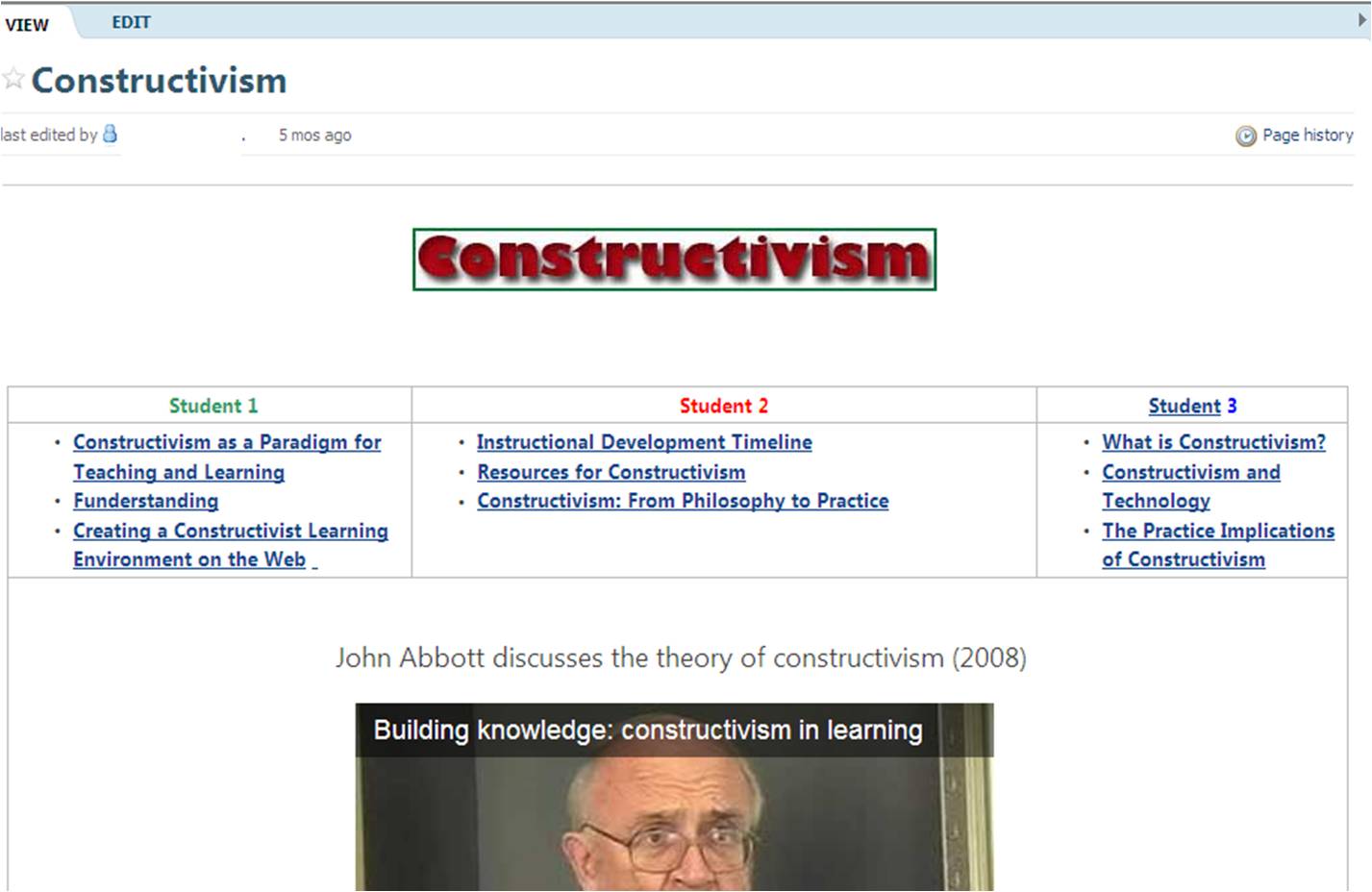
Figure 1. Constructivism Wiki Page
In an undergraduate social studies methods and field service course, students' final project was an interdisciplinary thematic unit on the wiki (see Figure 2). This complex task was assigned as a group project to a grade level team. Typically, each member of the team was given responsibility for a section on the final product.
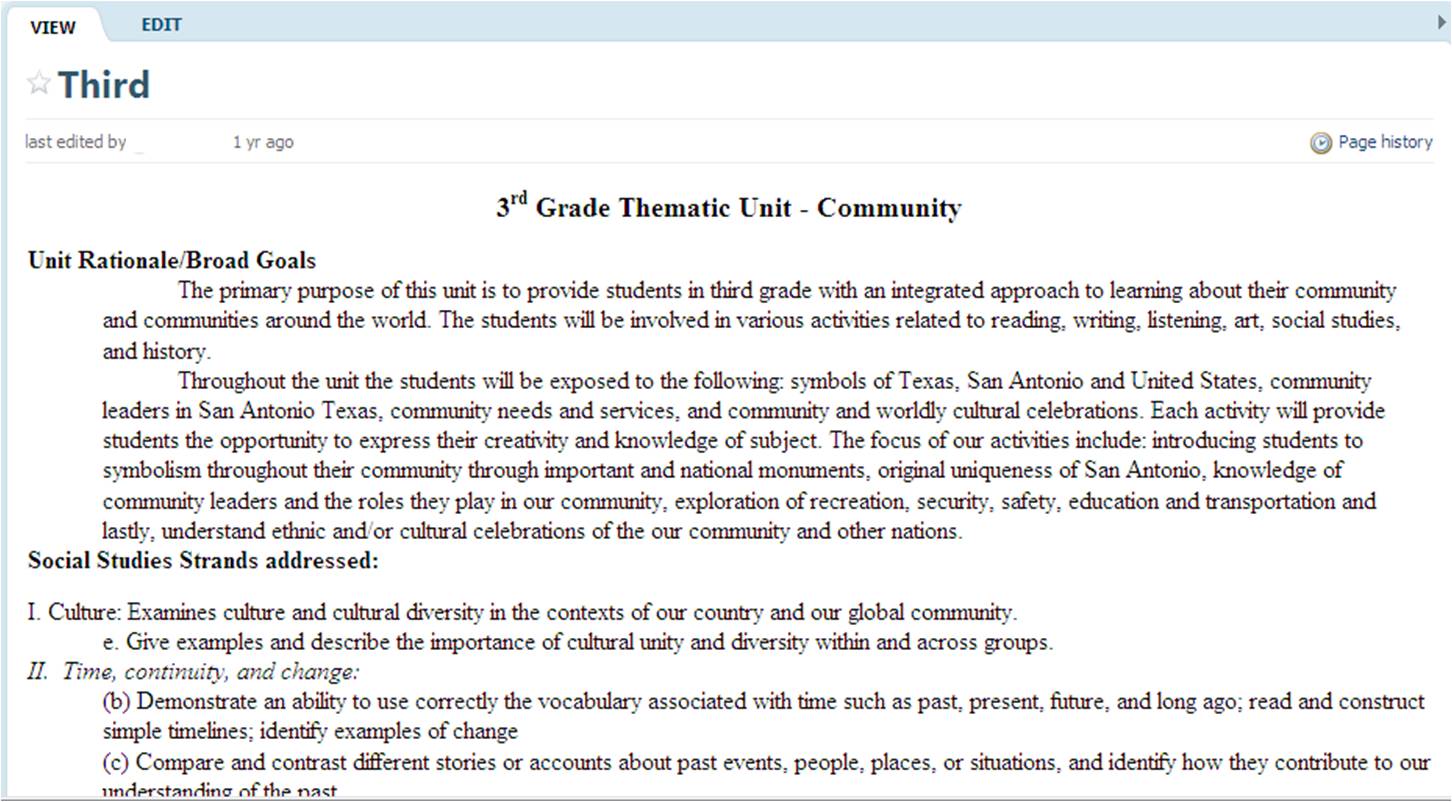
Figure 2. Thematic Unit Wiki Page
Moving the course project from paper format (most projects were 25–30 pages) to the wiki had multiple advantages. Since the latest version of the wiki is available 24 × 7 in a central place, students find they need fewer meetings to finish their work. The instructor can also periodically check on the progress of each team, intervening quickly if a team is lagging. Finally, the instructor can grade the final product from the wiki and then create a wiki archive where students in future classes can see the work done by previous classes.
Short-Term Designs
Wikis can also be used for short-term projects — usually scheduled for a week or for a short unit of instruction such as a chapter. Many of these designs use tables as a framework. Tables are created using wiki tools or in Word and copied and pasted into the wiki. Short-term designs include:
- Role play
- Video playlist
- Analysis grid
- Carroll Diagram
- Gallery walk
Role Play
In the role play design, students take the perspective of someone who is pertinent to the instruction. In the example in Figure 3, students were studying freedom of speech in digital environments. To help them understand this concept, they studied the case of the San Jose public library, which discontinued the use of web filters on their computers. Students played a person in the community (one persona per cell of the grid) and discussed how this decision would affect them. The role play personas represented a diverse group whose opinions regarding the decision would be very different. To begin, students read about the issue in the chapter and a news report from a local television station. They then went to the wiki page, chose a person to role play, and posted their comments. The community roles chosen for this project included the mayor, the head librarian, the children's librarian, an adult who occasionally surfed porn, a Chinese diplomat visiting the community, and a parent of small children, among others. Through participating in this project, students came to see the interplay of positive and negative rights regarding free speech in digital environments.
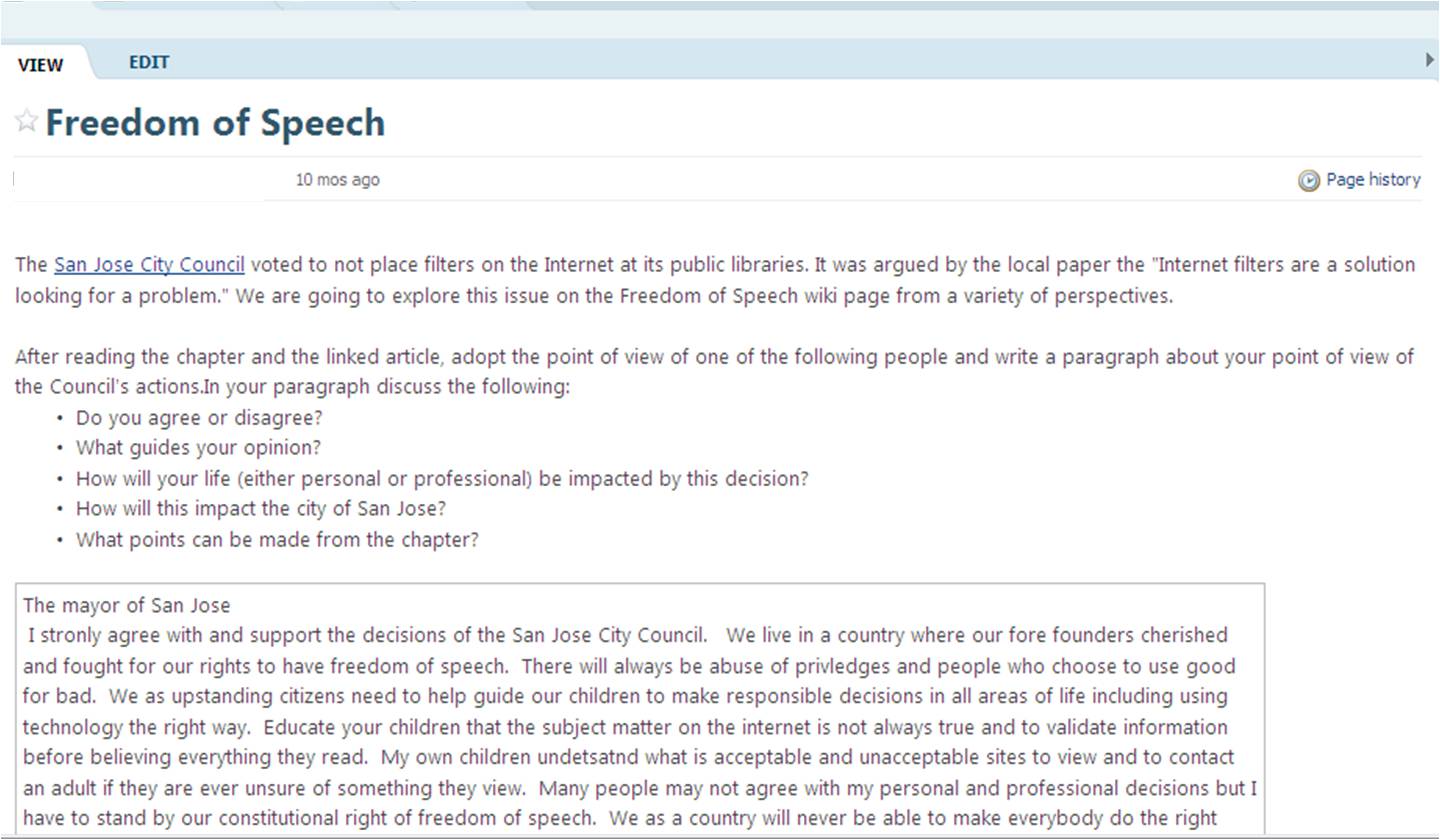
Figure 3. Role Play Wiki Page
Video Playlist
Similar to a bibliography, a video playlist is a compilation of video resources. Through the vast availability of video on the web, students can easily make connections between course concepts and the real world. For this wiki activity, students found a video on YouTube that illustrated an issue discussed in the opening chapter of the course. Each cell of a grid created on the wiki contained an issue from the course. Students could embed the video in the cell by following directions on the wiki. See an example of this wiki in Figure 4.
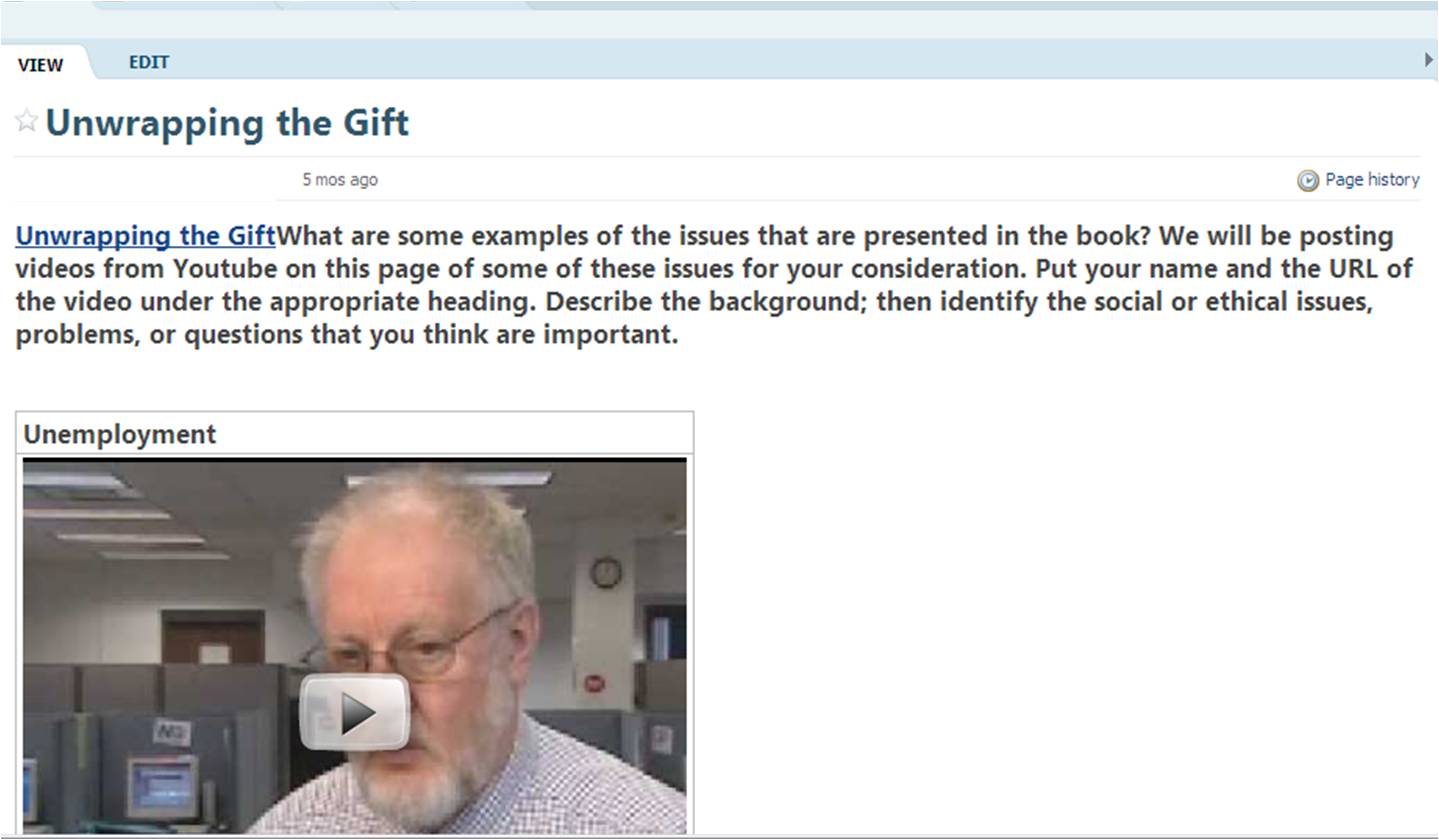
Figure 4. Video Playlist Wiki Page
Through this project, students came to understand not only the relevance of the issues to their lives but also that these issues are extremely complex. As one student who explored freedom of speech remarked:
"I looked up freedom of speech on internet issues on Youtube and I came across how the goverment [sic] is trying to control the web due to home[land] security issues. If I am understanding correctly, the goverment [sic] wants to have the authority to shut down private websites if they seem to be some kind of threat. If this is true, I understand the concern for homeland security, but at the same time, it is taking away our freedom of speech."
Granted, many videos in YouTube contain spurious information. Students should be cautioned to examine their contribution to the video playlist using the criteria commonly used for evaluating a website to determine the credibility of both the producer and the content.
Analysis Grid
Unlike blogs and discussion boards, which represent each student's contributions in isolation, the wiki places all students' ideas in the same place. Students can see how their ideas compare to those of their classmates, and there is less repetition. In those instances where the objective is to help students identify and organize similarities and differences or advantages and disadvantages, an analysis grid design would be useful.
In the assignment shown in Figure 5, students were asked to identify the advantages and disadvantages of synchronous and asynchronous distance learning tools, their possible use in a classroom, and where they should be positioned on Dale's Cone of Experience.7 Students were told to place their names by four tools in both modes that they chose to investigate and then to take these distance learning tools for a "test drive." They posted their evaluations of the advantages and disadvantages of these tools in the grid with the caveat that each person would add new information to the grid and that they should not repeat anything entered previously. Whether due to the wiki or that their entries were juxtaposed, responses tended to be longer and more thoughtful as a result of this design. This assignment had an extended time, however, because the entire class was accessing the same page.
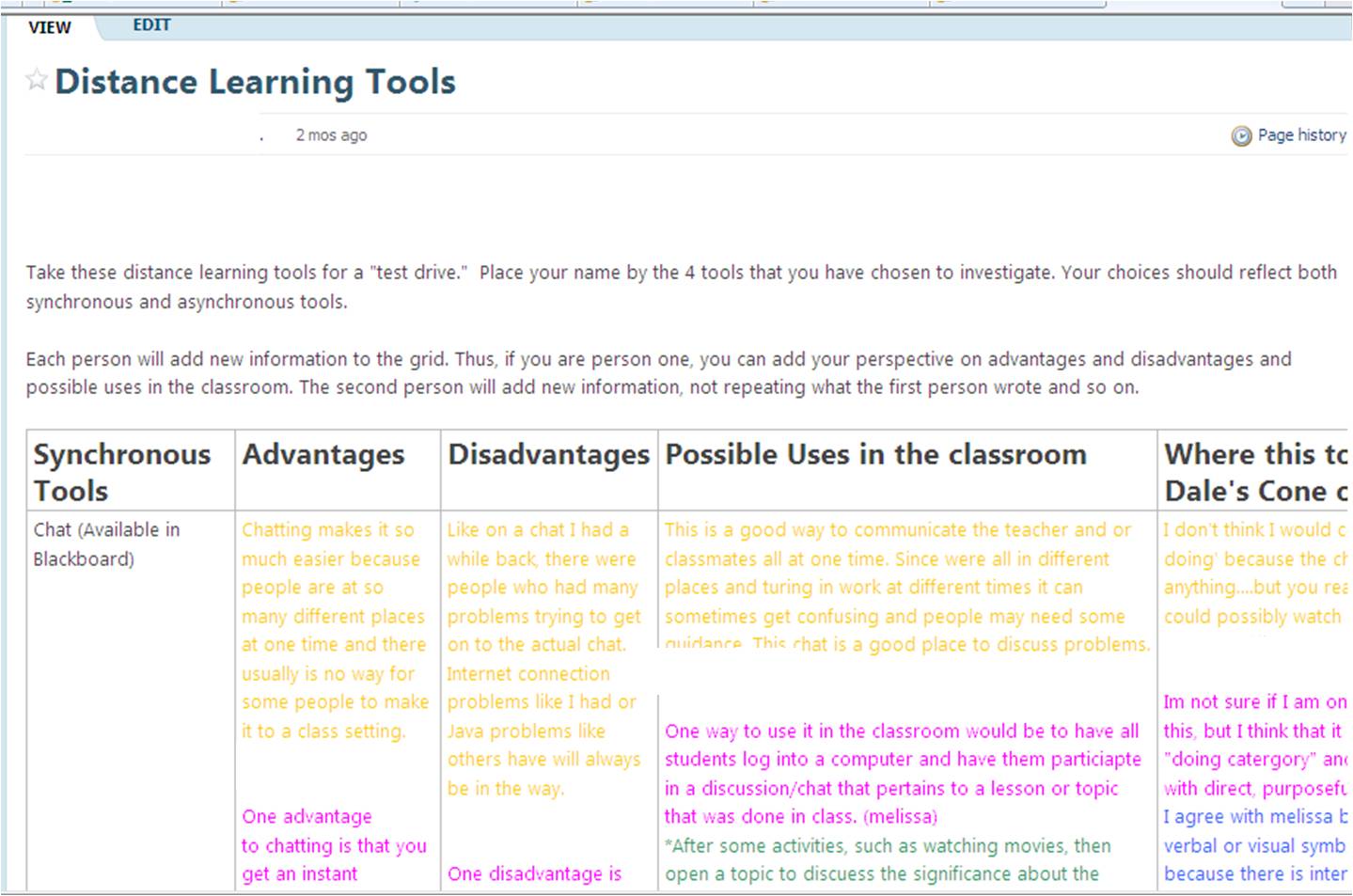
Figure 5. Analysis Grid Assignment
Carroll Diagram
The Carroll Diagram, created by Alice in Wonderland author and mathematician Lewis Carroll, is a type of logic diagram used to categorize and display information with two attributes, as shown in Table 1.
Table 1. Carroll Diagram of Numbers Between 1 and 10
| Prime | Not Prime | |
| Odd | 3, 5, 7 | 1, 9 |
| Not Odd | 2 | 4, 6, 8, 10 |
Students find understanding these matrices difficult. In the example shown in Figure 6, students were studying Mayer's Active Learning Matrix,8 which had an attribute of behavioral activity (low and high) and an attribute of cognitive engagement (low and high). To help them better understand each quadrant, they were asked to place an example of each quadrant's type of learning in the appropriate cell on the wiki. Had they posted that information in a blog or discussion board, it would have been decontextualized and abstract. By using the wiki, students could view their content in the appropriate context and compare their posting with other postings.
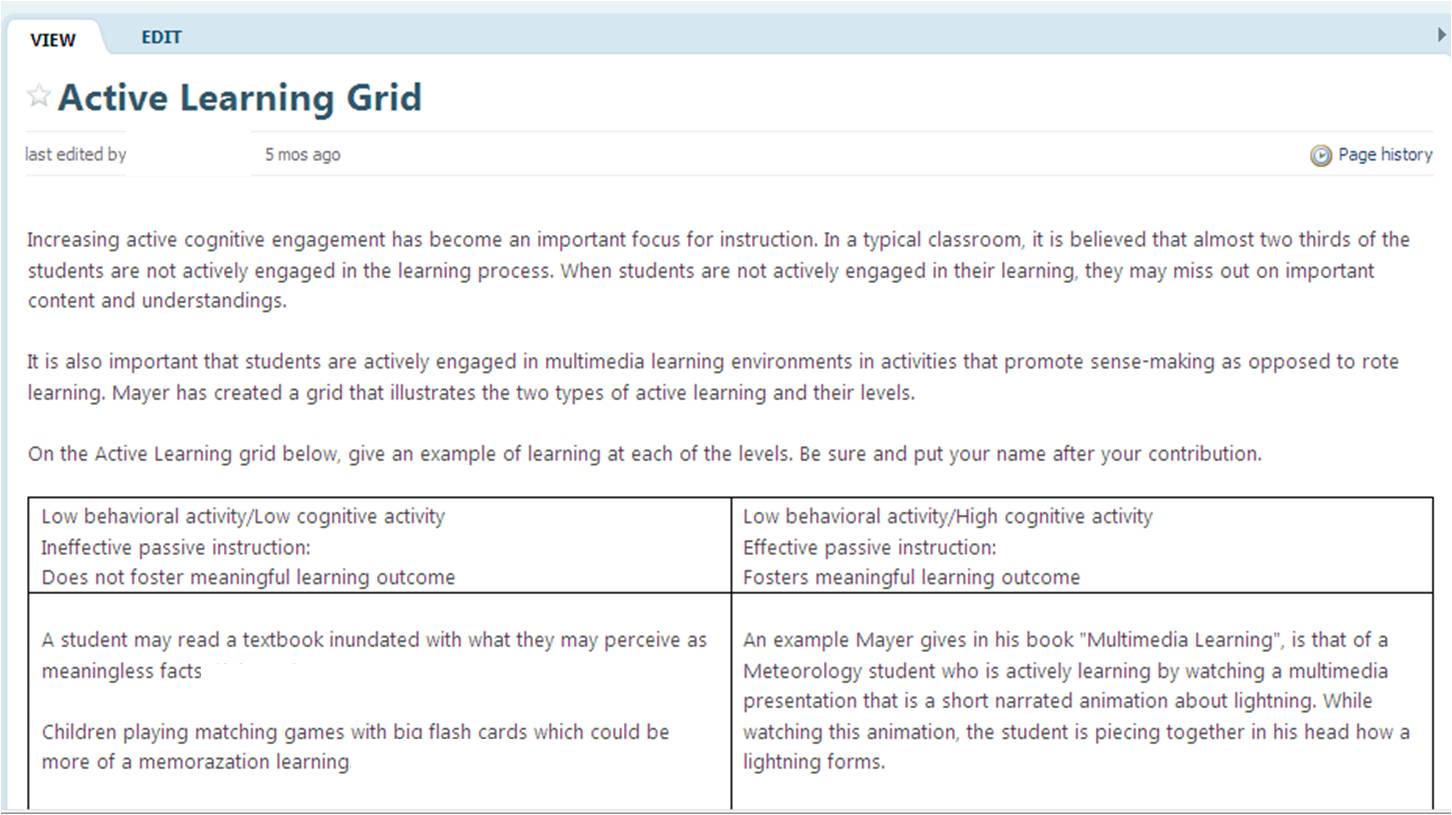
Figure 6. Carroll Diagram Grid
Gallery Walk
A typical gallery walk activity involves walking around the room and viewing each poster, while the gallery walk wiki page juxtaposes each student's contribution for a side-by-side comparison. In the gallery walk shown in Figure 7, students placed their example of a PowerPoint slide lacking Mayer's Coherence Principle9 next to an explanation of the slide's faults. Student comments reflecting on the importance of the coherence principle appear in the comments section at the bottom of the page.
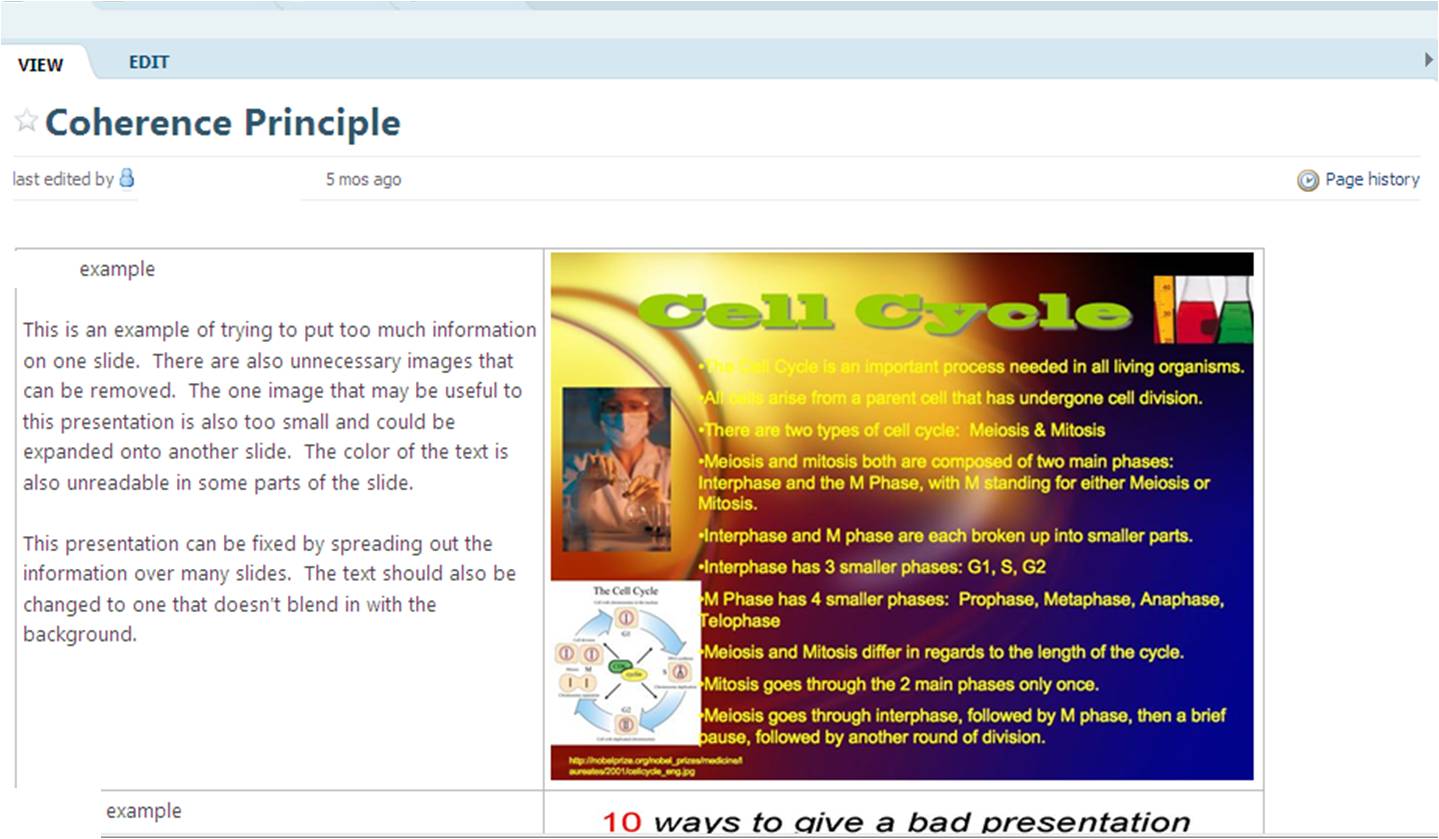
Figure 7. Gallery Walk Wiki
Dealing with Problems
Generally, course wikis require no more monitoring than other course websites. Informal monitoring is afforded through RSS feeds of changes. On a few occasions we have encountered some issues in working with a course wiki:
- Students need to be reminded that the ordinary norms of civility that apply in other course environments extend to wiki environments.
- If students accidentally erase the entire page, the page can be rolled back from page history. The only student who loses any work is the student who erased the page.
- While a student is editing a page, other students are locked out from editing. Students need to realize that wiki etiquette requires prompt edits and saves.
- Students need to be held accountable for participating in the collaborative process. Directions for the wiki project should include how participation will be evaluated.
Wiki Challenges
Researchers have noted positive effects to integrating wikis in higher ed courses,10 but others have noted problems. While students enjoy the shared space and ease of use of wikis and frequently add and delete information, they are reluctant to edit each other's work.11 Ioanou and Artino12 also reported that students felt uncomfortable editing another's work and looked upon this requirement as an additional pressure. In addition, a course with an emphasis on collaborative learning might be a mismatch for a student who prefers learning alone. A study of solitary learners revealed that while these learners valued the multiple perspectives provided by online discussions with peers, they preferred individual accomplishment of course-specific tasks and did not readily participate in collaborative instruction.13 Other students might not be comfortable in learning environments where they are expected to take ownership of their own learning, where changes in pedagogy might not fit their expectations and thus not be valued by them.14 Finally, students need preparation for these new authoring environments — instructors cannot automatically assume that students understand the mechanics of shared authoring and peer editing.
Conclusion
A colleague recently joked that we should divide time into pre- and post-wiki periods. While that might be an extreme reaction to our evangelism for wiki learning environments, wikis do provide a powerful, creative venue for collaboration. Students have expressed enthusiasm about the integration of wikis into our courses, with several students saying, "I need to know about this for my school" or "This was my favorite part of the course." New learning environments must address the changing nature of the learner and the technological tools that have become the heartbeat of this generation. At the heart of a wiki project is collaborative knowledge building by students, mediated by user-generated design. In our experience, this has led to increased student engagement. As Susan Kinzie observed, "Wikis can encourage creativity, remove the limits on class time, give professors a better sense of student understanding and interest, and keep students writing, thinking, and questioning."15
- Donald E. Heller and Madeleine d'Ambrosio, eds., Generational Shockwaves and the Implications for Higher Education, TIAA-CREF Institute Series on Higher Education (Cheltenham, UK: Edward Elgar, 2008); Marc Prensky, "Digital Natives, Digital Immigrants," On the Horizon, vol. 9, no. 5 (October 2001), pp. 1–2; and James A. West and Margaret L. West, Using Wikis for Online Collaboration: The Power of the Read-Write Web (San Francisco, CA: Jossey-Bass, 2009).
- Marc Prensky, Teaching Digital Natives: Partnering for Real Learning (Thousand Oaks, CA: Corwin, 2010); and Debra Sprague and Christopher Dede, "Constructivism in the Classroom: If I Teach This Way, Am I Doing My Job?" Learning & Leading with Technology, vol. 27, no. 1 (September 1999), pp. 6–9, 16–17.
- Robert E. Cummings and Matt Barton, Wiki Writing: Collaborative Learning in the College Classroom (Ann Arbor, MI: Digital Culture Books, an imprint of the University of Michigan Press and the University of Michigan Library, 2008).
- Bill Ferriter, "Learning With Blogs and Wikis," Educational Leadership, vol. 66, no. 5 (February 2009), pp. 34–38.
- George Veletsianos, Emerging Technologies in Distance Education (Edmonton: Athabasca University Press, July 2010).
- Panayiotis Zaphiris, Chee Siang Ang, and Andrew Laghos, "Online Communities," in The Human Computer Interaction Handbook: Fundamentals, Evolving Technologies, and Emerging Applications, Second Ed., Andrew Sears and Julie A. Jacko, eds. (New York, NY: Lawrence Erlbaum Associates, 2008), pp. 603–620.
- Stephen Petrina, "Advanced Teaching Methods for the Technology Classroom," International Journal of Technology and Design Education, vol. 17, no. 1 (2007), pp. 109–111.
- Richard E. Mayer, Multimedia Learning, Second Ed. (Cambridge, UK: Cambridge University Press, 2009).
- Ibid.
- Nicola Carr, "Wikis, Knowledge Building Communities, and Authentic Pedagogies in Pre-Service Teacher Education," in Hello! Where Are You in the Landscape of Educational Technology? Proceedings of ascilite Melbourne 2008, pp. 147–151; Irina Elgort, Alastair G. Smith, and Janet Toland, "Is Wiki an Effective Platform for Group Course Work?" Australasian Journal of Educational Technology, vol. 24, no. 2 (2008), pp. 195–210; and Steve Wheeler and Dawn Wheeler, "Using Wikis to Promote Quality Learning in Teacher Training," Learning, Media, and Technology, vol. 34, no. 1 (2009), pp. 1–10.
- Brian Foley and Tae Chang, "Wiki as a Professional Development Tool," in Proceedings of Society for Information Technology and Teacher Education International Conference (SITE) 2008,Karen McFerrin, Roberta Weber, Roger Carlsen, and Dee Anna Willis, eds. (Chesapeake, VA: AACE, 2008), pp. 2959–2966; Andri Ioannou and Anthony Artino, "Incorporating Wikis in an Educational Technology Course: Ideas, Reflections and Lessons Learned," in Proceedings of Society for Information Technology and Teacher Education International Conference (SITE) 2008,Karen McFerrin, Roberta Weber, Roger Carlsen, and Dee Anna Willis, eds. (Chesapeake, VA: AACE, 2008), pp. 3353–3358; and Edna Tal-Elhasid and Hagit Meishar-Tal, "Models for Activities, Collaboration and Assessment in Wiki in Academic Courses," in Electronic Proceedings of the Eden 2007 Annual Conference, June 13–16, 2007, Naples.
- Andri Ioannou and Anthony R. Artino Jr., "Wiki and Threaded Discussion for Online Collaborative Activities: Students' Perceptions and Use," Journal of Emerging Technologies in Web Intelligence, vol. 1, no. 1 (August 2009), pp. 97–106.
- Fengfeng Ke and Alison Carr-Chellman, "Solitary Learner in Online Collaborative Learning: A Disappointing Experience?" Quarterly Review of Distance Education, vol. 7, no. 3 (Fall 2006), pp. 249–265.
- Laura Zurita, "Learning in Multicultural Environments: Learners as Co-designers," paper presented at Networked Learning 2006, April 10–12, 2006, Lancaster, UK.
- Susan Kinzie, "Interactive Web Pages Changing Class Participation," Washington Post, March 11, 2005, p. B01.
© 2010 Marybeth Green and Gerri Maxwell. The text of this article is licensed under the Creative Commons Attribution-Noncommercial-No Derivative Works 3.0 license.
